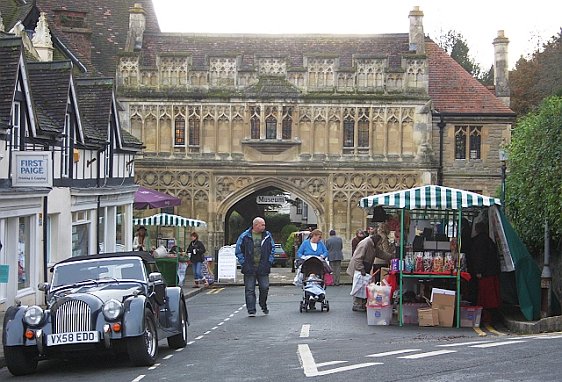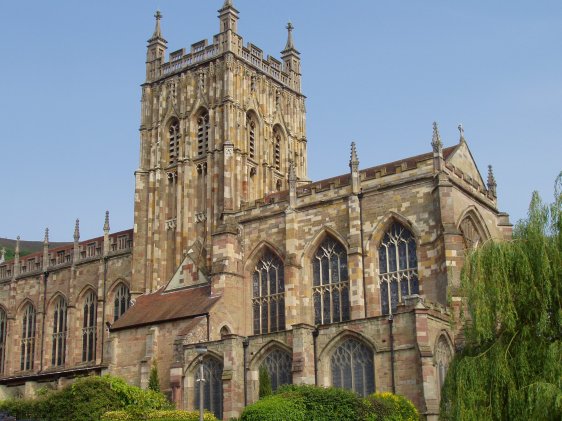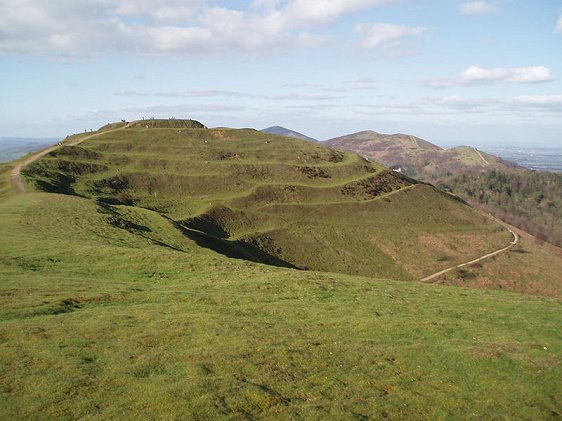 View of the Abbey Gateway in Malvern, Worcestershire: Source: https://commons.wikimedia.org/wiki/File:Christmas_fair_by_the_Abbey_Gateway_-_geograph.org.uk_-_1598927.jpg
View of the Abbey Gateway in Malvern, Worcestershire: Source: https://commons.wikimedia.org/wiki/File:Christmas_fair_by_the_Abbey_Gateway_-_geograph.org.uk_-_1598927.jpgAuthor: Bob Embleton

Malvern is a spa town in Malvern Hills district, on the southwestern part of Worcestershire, England. The town has a population of around 30,000 people (2012 estimate).
Human habitation in the Malvern Hills has been traced back to the Bronze Age, around 1000 BC, based on discovery of boundary earthwork from that period. The area was inhabited by the La Tène people around 250 BC; money bars of their culture were discovered here in the 19th century. A site of extensive Iron Age earthworks on the summit of the Malvern Hills is called the British Camp.
Little is known of Malvern during the Roman and Anglo Saxon periods of British history, and ancient folklore linking warfare between the ancient Britons agains the Romans in the area has not been backed by documentation or archaeological evidence.
Malvern reappeared in the Norman period, when the Malvern priory was mentioned. It is said to have existed before the Norman Conquest, meaning there is a continuity of human activity in the area going to the Anglo Saxon period, but details have remained somewhat sketchy today. The Saxon Earl Harold Godwinson built a motte-and-bailey castle over the earthworks of the British Camp. It was destroyed by King Henry II in 1155.
 Great Malvern Priory: Source: https://en.wikipedia.org/wiki/File:Great_Malvern_Priory.JPG
Great Malvern Priory: Source: https://en.wikipedia.org/wiki/File:Great_Malvern_Priory.JPGAuthor: Daderot

The Normans founded a Benedictine monastery in Malvern in the 11th century. Remains of it became part of present-day Great Malvern Priory. The Dissolution of the Monasteries brought incredible upheavels to the monastery, and Malvern Priory survived only through acquisition by one William Pinnocke. Apart from the church building and the Abbey Gateway, the rest of the monastic complex was demolished and anything usable was sold off.
The therapeutic properties of the spring water in Malvern was first recognized in 1612. It paved the way for the town to become a spa. Various physicians and recognized authorities heaped praise on Malvern water, boosting its popularity. As a result the water of Malvern was being bottled and shipped. Patients from all over England came to Malvern for hydrotheraphy, among them the Duchess of Teck, Charles Darwin, Florence Nightingale and Queen Adelaide.
The popularity of hydrotherapy declined towards the end of the 19th century, forcing Malvern to reinvent itself. It reemerged as a center for education. Many of its spa hotels were converted into private boarding schools. Today the town has modernized, its economy supported by manufacturing, agriculture, horticulture and service industries.
 British Camp, Malvern Hills: Source: https://commons.wikimedia.org/wiki/File:British_camp_central_mound_2005.jpg
British Camp, Malvern Hills: Source: https://commons.wikimedia.org/wiki/File:British_camp_central_mound_2005.jpgAuthor: Spoonfrog

Visiting Malvern
From London, take the M40 motorway, continuing on the M42 heading west and then the M5 heading south. Exit the M5 at Junction 7. then continue west on the A4440 until you reach the roundabout with the A449. Continue south on the A449 until arriving in Malvern.Places of Interest in Malvern
- Great Malvern Priory: Former Benedictine monastery from the 11th century. It is one of the oldest buildings still standing in Malvern.
- Malvern Hills: Hill where the ancient Iron Age fortification of British Camp is located.
 Latest updates on Penang Travel Tips
Latest updates on Penang Travel Tips
 Discover with Timothy YouTube Channel
Discover with Timothy YouTube Channel
 PG Food Channel
PG Food Channel
 Learn Penang Hokkien YouTube Channel
Learn Penang Hokkien YouTube Channel
 SojiMart Videos
SojiMart Videos
Latest from Discover with Timothy: Gurney Bay - what to see and do there
About this website

Hello and thanks for reading this page. My name is Timothy and my hobby is in describing places so that I can share the information with the general public. My website has become the go to site for a lot of people including students, teachers, journalists, etc. whenever they seek information on places, particularly those in Malaysia and Singapore. I have been doing this since 5 January 2003, for over twenty years already. You can read about me at Discover Timothy. By now I have compiled information on thousands of places, mostly in Peninsular Malaysia and Singapore, and I continue to add more almost every day. My goal is to describe every street in every town in Malaysia and Singapore.
Robbie's Roadmap
- Episode 1: Robbie's Journey to Financial Freedom
- Episode 2: Lost in America
- Episode 3: The Value of Money
- Episode 4: The Mentor
- Episode 5: The Thing that Makes Money
- Episode 6: The walk with a Billionaire
- Episode 7: The Financial Freedom Awakening
- Episode 8: Meet Mr Washington
- Episode 9: The Pizzeria Incident
Copyright © 2003-2024 Timothy Tye. All Rights Reserved.


 Go Back
Go Back